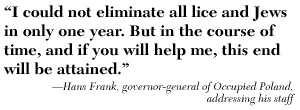
|
|
|

|

|

|

|
|
Click on an image to see a larger, more detailed picture.
|
|
|
|
|
| 1940: Machinery of Hatred |

|
pg. 201 |

|
|
|
|
| |

|
 Belgian Nazis post a sign that reads "V--sign of German victory." The antisemitic sign on the truck, with its caricature of a bloodthirsty Jew, reads: "The Jewish conspiracy against Europe. Join the Flemish volunteer regiment in the struggle against bolshevism." Established in September 1940, the Algemeene Schutscharen Vlaanderen (Flemish General SS) was the first of the Belgian collaborationist units. It was later joined by the Légion Wallonie (Wallonian Legion), which earned a reputation even within the SS for its fanaticism.
Belgian Nazis post a sign that reads "V--sign of German victory." The antisemitic sign on the truck, with its caricature of a bloodthirsty Jew, reads: "The Jewish conspiracy against Europe. Join the Flemish volunteer regiment in the struggle against bolshevism." Established in September 1940, the Algemeene Schutscharen Vlaanderen (Flemish General SS) was the first of the Belgian collaborationist units. It was later joined by the Légion Wallonie (Wallonian Legion), which earned a reputation even within the SS for its fanaticism.
Photo: Hoover Institution / United States Holocaust Memorial Museum Photo Archive
|
 A German racial hygienist and a police officer interview an elderly Gypsy woman. With the advent of modern industrial society, the Gypsies' nomadic lifestyle was out of step with the times. Throughout the early 20th century, government authorities attempted to coerce the 28,000 German Gypsies into establishing permanent residences and occupations. Once in power, the Nazis intensified this pressure. The Nuremberg Laws of 1935 were applied to the Gypsies, and thousands of the people were eventually placed in concentration camps. Together with Jews, Gypsies were relocated to the Generalgouvernement in Poland.
A German racial hygienist and a police officer interview an elderly Gypsy woman. With the advent of modern industrial society, the Gypsies' nomadic lifestyle was out of step with the times. Throughout the early 20th century, government authorities attempted to coerce the 28,000 German Gypsies into establishing permanent residences and occupations. Once in power, the Nazis intensified this pressure. The Nuremberg Laws of 1935 were applied to the Gypsies, and thousands of the people were eventually placed in concentration camps. Together with Jews, Gypsies were relocated to the Generalgouvernement in Poland.
Photo: Bundesarchiv / United States Holocaust Memorial Museum Photo Archive
|
 Hans Frank (left) was the head of the Generalgouvernement. This region in Poland became a "dumping ground" for Jews, and Frank was intimately involved in the atrocities carried out under his jurisdiction. Under Frank's orders, the Poles were ruthlessly exploited, public treasures were seized, and thousands of innocents were executed. During 1940 the ghettoization of the Jews proceeded at a rapid pace.
Hans Frank (left) was the head of the Generalgouvernement. This region in Poland became a "dumping ground" for Jews, and Frank was intimately involved in the atrocities carried out under his jurisdiction. Under Frank's orders, the Poles were ruthlessly exploited, public treasures were seized, and thousands of innocents were executed. During 1940 the ghettoization of the Jews proceeded at a rapid pace.
Photo: National Archives / United States Holocaust Memorial Museum Photo Archive
|
|

|

|

|

|
 August 25, 1940: The first British air raid is launched against Berlin.
August 25, 1940: The first British air raid is launched against Berlin.
|
 August 26, 1940: German-Jewish philosopher Walter Benjamin commits suicide in Spain, after local authorities threaten to return him to Germany.
August 26, 1940: German-Jewish philosopher Walter Benjamin commits suicide in Spain, after local authorities threaten to return him to Germany.
|
 August 27, 1940: France's collaborationist government, headed by Marshal Philippe Pétain, invalidates the March 21, 1939, French decree prohibiting incitement to race hatred.
August 27, 1940: France's collaborationist government, headed by Marshal Philippe Pétain, invalidates the March 21, 1939, French decree prohibiting incitement to race hatred.
|
 September 1940: Polish underground officer Witold Pilecki penetrates the main camp at Auschwitz with the intention of organizing secret resistance groups inside the camp.
September 1940: Polish underground officer Witold Pilecki penetrates the main camp at Auschwitz with the intention of organizing secret resistance groups inside the camp.
|
 September 1940: The National Legionary government of dictator Ion Antonescu assumes power in Romania.
September 1940: The National Legionary government of dictator Ion Antonescu assumes power in Romania.
|
 September 1940: In Belgium, a collaborationist military unit, Algemeene Schutscharen Vlaanderen (Flemish General SS), is established.
September 1940: In Belgium, a collaborationist military unit, Algemeene Schutscharen Vlaanderen (Flemish General SS), is established.
|
 September 1, 1940: Soviet authorities order Japanese Consul Sempo Sugihara to leave Kovno, Lithuania, where he has issued 3500 exit visas to Jews.
September 1, 1940: Soviet authorities order Japanese Consul Sempo Sugihara to leave Kovno, Lithuania, where he has issued 3500 exit visas to Jews.
|
|
|
|
|
| 1940: Machinery of Hatred |

|
pg. 201 |

|
|
The Holocaust Chronicle
© 2009 Publications International, Ltd.
|
|
